part five in the series, The Route Not Taken
Imagine what this peaceful area today was like in the 19th century with a tannery just south of a blacksmith shop—certainly noisy, and probably very smelly. Add a rail line passing through and you would have had a very different environment from today.
Part Four left off with the farms of Cornelius & Elizabeth Higgins and Asher & Mary Ann Johnson, located along Route 523 south of Sergeantsville. The next person on the list of landowners prepared by the company’s engineer was Charles Green.
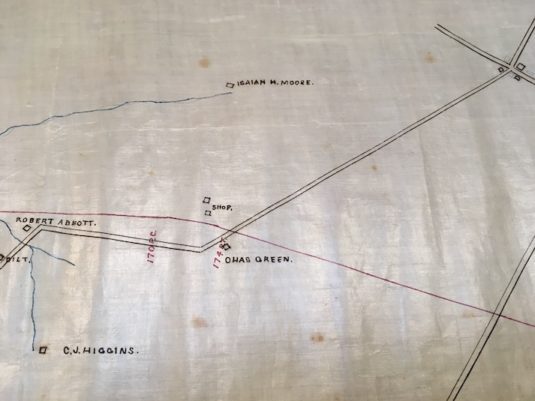
Before proceeding, I should point out that the survey map as shown in the detail above indicates “Robert Abbott” on part of the tannery property owned by Henry Lawshe. In my previous article, I focused on Jonathan Dilts, who ran the tannery for awhile. I stayed away from Robert Abbott because he was causing me problems. However, he will appear in the next article in this series, living in another location
Isaiah H. Moore & Mary Lake
Beers: “L. H. Moore”
Railroad Survey & Slaymaker : Isaiah H. Moore
Cramer Survey: “I. H. Moore: 96 acres, 600 bearing peach trees, 300 baskets of peaches, uses Penna RR, 600 young peach trees, 2 tons of coal, 1.25 tons of fertilizer, 420 cans of milk, 6 calves sold, 750 lb of poultry, 1,000 lb of pork, 15 bushels of apples
The map detail shows Isaiah Moore’s property toward the top. Although he was listed as a landowner, I suspect the only part of his property that the rail line would cross was his access lane to Route 523, as his farm was to the north of land owned by Charles Green. That is also the case with the next owner listed, John H. Gordon.
Isaiah H. Moore (1815-1885) was the son of David Moore, Sr. and Elizabeth Hudnut (see Moore Family Tree). His name is often spelled Isaiah A. Moore, but since his mother’s maiden name was Hudnut or Hudnit, “H” seems more likely.
He grew up in the area where the Sandbrook Headquarters Road meets the road from Sergeantsville to Ringoes (i.e., Route 604). In 1837, he married Mary Lake, daughter of Cornelius Lake and Lydia Haines. Lydia Haines (1780-1856) was the daughter of Joseph Haines and Anna Moore, a family that lived near David & Elizabeth Moore. She was the second wife of Cornelius Lake.1
Isaiah and Mary Moore had five children, two of whom died as infants. Their son Edward, born in 1841, died age 29 in 1871, only one year after marrying Mary Jane Cronce. Their daughter Lydia, born in 1850, married Andrew M. W. Abbott, and their son Cornelius Lake Moore, born in 1853, married Elizabeth A. Stevenson.
Cornelius Lake (1763-1842), whose farm covered much of the southwest corner of Sergeantsville, had been a fixture in the area for most of his life, serving a Commissioner of Deeds for many years and frequently witnessing documents for his neighbors.
The first recorded real estate transaction for Isaiah H. Moore was on April 6, 1840 when he bought the tavern at Sergeantsville (which today is the Township Hall, not the restaurant known as the Sergeantsville Inn). He paid $2300 for a lot of 27+ acres,2 and obtained tavern licenses for the years 1840 and 1841.
By this time, Cornelius Lake was in his late-70s and probably in ill health. It appears that Isaiah & Mary Moore agreed to move in with the Lakes, because on May 9, 1842, the Moores sold the tavern lot to David Rake, for a small profit of $300.3 On May 20, 1842, Cornelius Lake wrote his will, leaving “the farm I live on” to his wife Lydia, and after her death to his daughter Mary Moore. Cornelius Lake died on Dec 18, 1842, age 80, and his widow Lydia died in 1856.
By the 1870s, judging by the Cramer survey (details above), Isaiah H. Moore was an active farmer. But as often happened, even skilled farmers had trouble with their horses. On September 19, 1872, the Hunterdon Republican reported that “Mr. Isaiah Moore of Sergeantsville was driving out on Friday last when his horse became frightened and upset the carriage; Mr. Moore was considerably injured but it is hoped not seriously.” The only other mention of Moore in the Republican was in the August 12, 1885 edition, when a “cyclone” hit Delaware Township and damaged Moore’s buildings and peach trees.
The Republican did not publish an obituary for Isaiah H. Moore, but the Democrat did, in its April 8, 1886 edition, as follows:
Isaiah Moore, an old and well known resident of Sergeantsville, was buried last Tuesday. He had been failing for some time and on the Thursday previous was taken with paralysis and died on Friday.4
Mary Lake Moore died, age 74, on October 3, 1891. Her heirs divided the farm into two lots, and on March 31, 1892, sold a lot of 10.78 acres to Sylvester Huff and on April 1, 1892, sold an 84.06-acre farm to Sarah E. Reading, wife of Joseph C. Reading.5
John H. Gordon & Catherine Case
Beers: “J. H. Gordon”
Survey Map: not shown
Slaymaker: “John H. Gordon”
Cramer Survey: not listed
John H. Gordon (1797-1876), son of Othniel Gordon and Mary Heath (see Gordon Family Tree), married in 1828 Catherine Case (1797-1886), daughter of Tunis Case and Elizabeth Landis. By the time that the rail line was surveyed, the Gordons were well advanced in age, both being 76 years old. Gordon’s property was not shown on the survey map, but the Beers Atlas has a detail showing the village of Sergeantsville in 1873, and J. H. Gordon is shown with a lot that extends from the west side of the village to Route 523 on the south.
The farm was sold to the Gordons by Cornelius & Lydia Lake in 1832, and consisted of two lots, one of 19.06 acres, and the other of 0.6 acres on the southwest corner of Sergeantsville, bordering other land of Cornelius Lake.6 In 1865, Gordon was charged an income tax of $18.60.
In 1872, John H. and Catharine Gordon sold a small lot on Route 523 to their neighbor, Charles Green, being part of the tract sold to them by Cornelius Lake in 1832.
There is not much to say about John H. Gordon. The only mention of him in the abstracts from the Hunterdon Gazette is that in 1840 he was among the Delaware Township supporters of Henry Harrison.
John H. Gordon died on October 22, 1876, age 79, and was buried in the cemetery attached to the Methodist Church in Sergeantsville. Six months later, his widow Catherine, daughter Letitia and her husband James P. Dilts, and daughter Sarah Gordon conveyed the farm, which then contained 43.79 acres to Gordon’s son-in-law Joseph Williamson, who paid $4,500 for it.7 Joseph Williamson (1839-1900) started out as a local school teacher, who was known to Egbert T. Bush. He was active in local Democratic politics, and in 1863 was elected vice-president of the township’s Democratic club. He married Mary A. Gordon (1839-1908) in 1864, when the Civil War was nearly over. Mary’s mother Catherine Gordon remained in her home until her death on December 26, 1886, after which she was buried next to her husband.
Joseph Williamson established a creamery on this farm in 1881, but that is another story.
Charles Green & Rebecca Ann Smith
Beers: “C. Green”
Survey Map: “Chas. Green”
Slaymaker: “Charles Green”
Cramer Survey: 57 acres, 5 tons coal, 500 #7, 400 lb lime, 3 #9, 630 cans milk, 9 #11, 750 lb poultry, 700 lb pork, 65 bushels potatoes, 75 bushels apples. – surprising totals for someone known as a blacksmith.
With a name like Green, one would think this family dates back to the original Green settler in Amwell Township, Samuel Green, who appeared in this area as early as 1701, and left descendants behind after moving on to Sussex County (see “The Greens of Amwell” for his history). But that is not the case.8
Charles Green (1812-1894) was one of the nine children of Peter Green (1772-1852) and Abigail Townsend (1773-1856) who settled in Franklin Township sometime early in the 19th century. Peter and Abigail, who married in 1791, came to Franklin Township from Southfield, Rockland County, NY. Of their nine children, eight were born in New York State. The family probably did not arrive in Hunterdon County until about 1813. The next year their youngest child, Deborah, was born here.
In 1832, when he was 20 years old, Charles Green married Rebecca Ann Smith (1815-1893), daughter of Mahlon Smith and Phoebe Dilts of Flemington. Mahlon Smith was a blacksmith who bought a lot on Flemington’s Main Street in 1818 from Elnathan Moore.9 There he operated a fairly large shop employing four men, producing mill stones and custom work.10 One of those men was Charles Green. In 1844, Charles Green was still employed as a blacksmith, and put this notice in the Hunterdon Gazette:
LOOK AT THIS ! BLACKSMITHING ! ! THE subscriber informs his friends and the public, that he still continues the Blacksmithing business, at the old stand, formerly occupied by Mahlon Smith, where he will be found ever ready to do all kinds of work in his line, at the shortest notice, and in the very best manner. He considers himself competent to do any and all kinds of work, in all the branches belonging to his business, and will warrant all warrantable work done in his shop. Thankful for past favors, he pledges himself that nothing shall he wanting on his part to meet a continuance of the patronage of his friends and the public. CHARLES GREEN. Flemington, March 13, 1844.
In the 1850 census for Raritan Township, Charles Green, age 39, was still working as a blacksmith. His wife Rebecca was 35, and they had eight children under the age of 17, including a son named Mahlon. Mahlon Smith the elder was listed as age 55, occupied as a farmer, not a blacksmith.
Oddly enough, I did not find a deed in which Mahlon Smith conveyed his Flemington blacksmithing property to Charles Green.11 Deed records also do not clearly show this, but it appears that in the 1850s, Charles and Rebecca Green moved to Delaware Township. They were listed there in the 1860 census, with Green working as a farmer, but his son Eldridge, age 20, was occupied there as a blacksmith. That same year, Mahlon Smith was listed in Flemington Borough, age 67, blacksmith. It looks as if Mahlon Smith returned to blacksmithing when Charles Green moved to Delaware Township.
In 1865, an income tax was levied to help retire the war debt. Charles Green of Sergeantsville was taxed $30.80, which was more than most of his neighbors were charged, excepting the tanner Henry Lawshe, who was charged $46.35.
It was not until 1867 that Charles and Rebecca Green bought a lot in the vicinity of Sergeantsville. They paid $1,100 for “a certain house & lot of a quarter of an acre bordering the Great Road from Flemington to Centre Bridge, William Lawshe and Henry H. Fisher.” It was sold to them by Eldridge C. & Margaret Green of Delaware twp.12
The next year, the Greens found a location they would remain at. On March 12, 1868, Jacob and Sarah Hoff sold them a lot of 44.09 acres on the road from Sergeantsville to Centre Bridge.13 According to the Delaware Twp. Historic Sites Survey, there already was a house on the east side of Route 523, built between 1830 and 1850, but it was subsequently “enlarged and remodeled,” and I suspect that was the work of Charles Green, who wanted a house that reflected his prosperity and good taste.
A shame about the electrical wires and high hedges, but you get the idea.
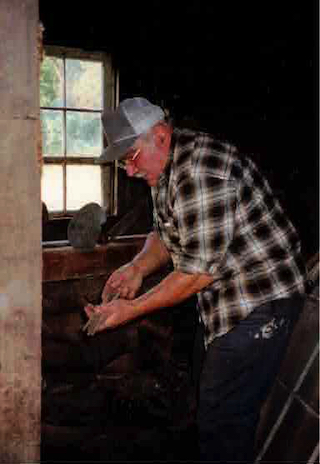
Take another look at the detail above of the railroad survey map. It shows the line running across the front of what was once the Maresca farm, crossing Route 523, and proceeding next to the Victorian house on the east side of the road. I can’t imagine Charles Green was any too pleased with that.
A couple months after buying the farm and house on the east side of the road from the Hoffs, Charles Green bought the blacksmith lot on the west side of the road from Elias & Elizabeth D. Bowne. It had been occupied by Elias’ father John Deats Bowne, for many years, he being famous for the plow he invented. Several years ago, that property was owned by the Maresca Brothers. Joe Maresca gave me a tour of the many outbuildings on the property, some of which still contained old blacksmithing tools.
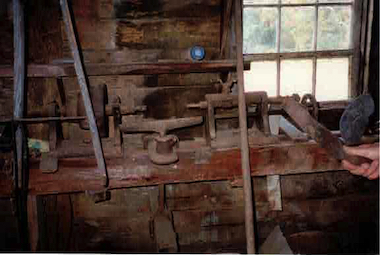
In subsequent years, Charles Green worked as both a farmer and a blacksmith and was moderately prosperous. However, accidents were known to happen. In 1875, Green drove his wagon & team of horses to the railroad station at Stockton, where he was probably expecting to collect some goods from an arriving train. He had gotten out and was standing next to the wagon on the station platform when the horses “became frightened and started to go.” Green reached out to stop them, but fell to the ground, hitting his head. The Hunterdon Republican newspaper reported that he was “seriously hurt.”14
But that was nothing compared to a report in 1882 that claimed that Charles Green of Sergeantsville had died. That was on June 8th. A week later, on June 15, 1882, the Republican published this: “The report that Charles Green of Sergeantsville was dead is not true. He has been very sick but is now on the mend.”
He must have mended well, because he and Rebecca celebrated their 50th wedding anniversary on September 2, 1882. The Republican reported that
“There were about 70 of their relatives and friends in attendance. The father of Mrs. Green, Mahlon Smith of Flemington, was present. His children presented him with a gold headed cane. There were 22 grandchildren, 35 great grandchildren and 1 G. G. grandchildren present. They were married in the Flemington Presbyterian Church on 2 Sept. 1832, and lived in that town for many years before moving to Delaware Tp.”
The couple also celebrated their 55th wedding anniversary in 1887. The announcement for that event added an item that was neglected five years before. For their 50th anniversary, the couple gave their children each a $5.00 gold piece and the grandchildren each a $1.00 gold piece.
The Greens were still together in 1892 when they celebrated their 60th anniversary. By then Charles was 80 years old and Rebecca was 77, and they had sold the blacksmith lot to their son James C. Green who carried on the blacksmithing trade until the 1900s when he and wife Salome Carrell move to Lambertville.
Rebecca Smith Green died on March 1, 1893. Charles Green died on August 31, 1894. The couple were buried in the Rosemont Cemetery.
As the survey map shows, the rail line was planned to run between the shops on the east side of Route 523 and Green’s house on the west side. After that it was supposed to turn east to run through the southern part of Sergeantsville, through the property of Henry H. & Anna Fisher and the property of Fulper & Dilts.
Sergeantsville
Henry H. Fisher & Anna Johnson
Beers: “H. H. Fisher”
Survey Map: not shown
Slaymaker: “Henry H. Fisher”
Pd $16 in 1865 taxes; listed at Tumble Falls.
Henry Hearl Fisher (1801-1881), son of Rev. George Fisher and Hannah Hillier (Fisher Family Tree), married in 1838 Anna Johnson (1815-1878), daughter of William Johnson and Urania Sergeant. In my article, Sergeantsville Inn part two, I wrote that Fisher’s first land purchase in Delaware Township took place in 1830, when Jonas and Anna Thatcher sold him the lot where today’s Sergeantsville Inn is located. He sold the Inn lot to John Farley Shepherd in 1868, but he kept ownership of a store lot across the road, which appears in the Beers Atlas detail of Sergeantsville, the until his death in 1881, when it was sold to William J. Fisher.
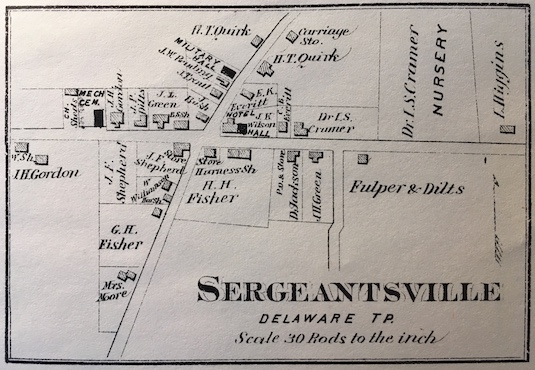 The inn lot and the store lot were just a couple of the many many properties bought and sold by Fisher during his lifetime. In the 1850 and 1860 census records, Fisher identified himself as a merchant. In 1870, he called himself a farmer, but by 1880, he was a “retired merchant.” Apparently ‘real estate investor’ was not considered an occupation.
The inn lot and the store lot were just a couple of the many many properties bought and sold by Fisher during his lifetime. In the 1850 and 1860 census records, Fisher identified himself as a merchant. In 1870, he called himself a farmer, but by 1880, he was a “retired merchant.” Apparently ‘real estate investor’ was not considered an occupation.
Fulper & Dilts
Beers: “Fulper & Dilts”
Survey Map, not shown
Slaymaker: “Dilts & Fulper”
This was a curious partnership. In 1865, William Fulper (1790-1882), son of Jacob Fulper and Catharine Hoppock, single, partnered with the husband of his niece Elizabeth Fulper Dilts (1819-1904) to purchase a tract of 116.21 acres in Sergeantsville from Jonathan & Asenath Fisher for $5800, excepting out four lots amounting to 60 acres that had been previously sold. Elizabeth’s husband was William M. Dilts (1821-1902), son of John Dilts and Rachel Lawshe Moore. (See Dilts Family Tree.)
Their property is shown on the Sergeantsville detail map in Beers Atlas (above), and also on the larger map of Delaware Township. Today, part of the lot is the location of a modern development and a new road, Jurgensen Road, named for the family that owned the property in the 20th century.
I have not been able to determine what the nature of this partnership was. It appears not to have been commercial. Their land purchase was recorded under their individual names; it was not listed in the index section reserved for Corporations. Dilts was always identified in census records as a carpenter and Fulper as a farmer.15
Whatever the case, it endured to the end of their lives. In his will, William Fulper left his share of the property to his niece Elizabeth.16 And in 1902, William M. Dilts bequeathed his share to his wife Elizabeth. By that time, the couple was living in “East Raritan” Township, not in Delaware Township. So, for a brief time, Elizabeth Fulper Dilts had full title to the property. After her death in 1904, her executor, George H. Hanson, sold the property to Elizabeth’s nephew, James Buchanan Fulper, for only $2800.17
James B. Fulper and wife Sarah had been living in Franklin Township until Sarah died in 1895. Thereafter he rented the Sergeantsville farm until his aunt’s executor sold it to him. He remained there until 1913 when he sold the farm to Christian and Maria Jurgensen. Their son, Charles Jurgensen, who died in 2008, was a student of Delaware Township history who shared a great deal of information with me.
The next two names on the route are “R. L. Abbott” and “James Carrel.” Researching their properties turned out to be a bigger project than I expected, so I have saved them for the next post, “Route Not Taken, part four.”
Postscript:
I had not gotten a copy of William Fulper’s will before publishing this article. What was stated in the will was that Fulper bequeathed to Elizabeth Dilts, wife of William M. Dilts all his “lands, tenements, hereditaments and real estate whatever.” He left sums of money to his sister Amy Rake, to Sarah Romine, wife of Asa Romine, and to Asher Fulper. He named William M. Dilts and Henry I. Quirk his executors, and his will was witnessed by Jacob L. Green and William J. Fulper.
This was interesting to me because I did not know that Amy Rake was his sister. She was married to Jacob F. Rake, and was William’s only surviving sibling. Sarah Romine and Asher Fulper were children of William’s brother Peter Fulper and Jerusha Larew, both of whom (Peter and Jerusha) had long predeceased William Fulper, who was 92 when he died.
Footnotes:
- His first wife, Mary Sergeant, had died in 1813, age 48, after giving birth to three children; see the LAKE family tree; see also The Haines Farm and Haines Farm, part two. ↩
- H.C. Deed Book 73 p. 247. ↩
- H.C. Deed Book 77 p. 441. ↩
- Taken from “Abstracts of the Hunterdon Democrat” by Dennis Sutton. However, according to the NJ Death & Burial Records Index available on Ancestry.com, Moore died on March 19, 1885, age 71. It would help if we knew where he was buried, but his grave has not been located. Here I should note a problem with the Hartman abstracts of notices in the Hunterdon Republican. He reported the obituary notice for Mary Lake, and followed it with this statement: “Death in Sergeantsville. Date: 3 Oct. 1891. Name: MOORE, Mary, Mrs., aged 74 years, 2 months and 19 days. From 1880 US Census for Delaware Tp. She leaves a husband, MOORE, Isaiah H., aged 65 and a son, MOORE, Cornelius, aged 25 years, both in 1880. No other information.” As stated, information on the husband and son came from the 1880 census. But we cannot assume that Isaiah outlived his wife from that reference. ↩
- H.C. Deeds Book 232 p. 635 and Book 233 p. 137. ↩
- H.C. Deeds Book 52 pp. 370, 373. ↩
- H.C. Deed Book 169 p. 220. ↩
- While researching the question of who Charles Green was related to and when he came to Delaware Township, I discovered information about this brother Peter Green, Jr., who also bought land in Sergeantsville. In fact, Peter Green became a better-known blacksmith because he owned the shop that is now used by the radio station WDVR. However, I will have to save all that for another time. ↩
- H.C. Deed Book 29 p. 465. Later, in 1834 bought a property near the old Agway lot from Cornelius Wyckoff’s estate, H. C. Deed Book 57 p. 106. ↩
- According to the manufacturing schedule of the 1820 census. ↩
- Note: there were five Mahlon Smiths born between 1793 and 1813, including one who lived in Delaware Twp., known as Mahlon Smith, Esq. ↩
- H. C. Deed Book 139 p. 234. Surprisingly, Eldridge C. Green and Charles Green were not directly related, even though Green’s son, who was about the same age, was also named Eldridge. The Eldridge who sold Charles Green the Sergeantsville lot was Eldridge C. Green (c.1841-after 1910), son of Hiram Green & Sarah Crooks, husband of Margaret Hill. Charles Green’s son Eldridge married Harriet Sergeant. The census records for 1880 show that the two Eldridge Greens were different people. ↩
- H. C. Deed Book 140 p. 320. ↩
- Hunterdon Republican, Jan. 21, 1875. ↩
- Snell’s History of Hunterdon County has nothing to say about the partners or their business. ↩
- H. C. Wills, Book 14 p. 93. ↩
- H. C. Deed Book 235 p. 269. ↩
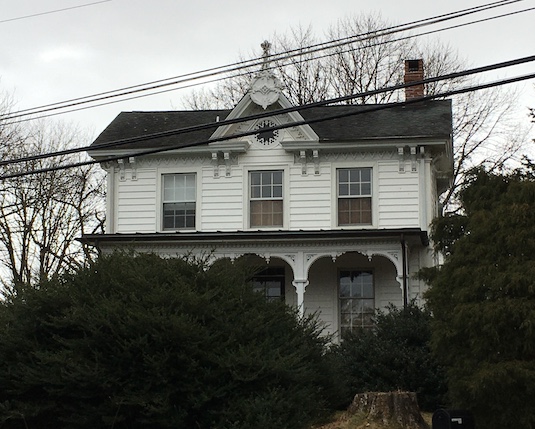
Ramona Hillier-O'Hara
January 16, 2020 @ 4:48 pm
Hi Marfy,
Love the work on Sergeantsville and families! The farm owned – but not lived in- by the Maresca Brothers was owned for many years by my great aunt Anna Larison Venable (1881-1964) and her husband Ed. (My great grandfather, Andrew Butterfoss Larison, 1873-1941 was her brother) They had no children, so my Dad spent summers there in the 1930’s. At the time Ed was a butcher as well as having sheep and hogs. They delivered meat in a horse and cart, according to my father. Joe Maresca told me that it was Uncle Ed who taught them how to be butchers. I visited the farm in the 60’s; Aunt Anna made her own cottage cheese and I was amazed! I was also fascinated by all the old blacksmith tools and farm equipment as a child, but scared of the hogs. And I was so happy when the current family saved all the old buildings. Thank you for all you do for us in writing about the local families.